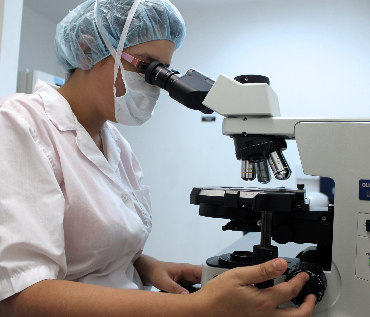Table of Contents
4. Traditional methods of Colony Counting
5. Limitations of Traditional Methods
6. Advantages of Colony counters
Introduction
A Colony counter is an instrument to quantify the number of colonies grown on a medium plate. It is one of the essential instruments in the labs that need to analyze many microbial plates regularly.
Colony counters accurately count the colonies, record data, and generate reports for you. Thus minimizing the chances of manual error and saving your time.
This blog discusses the basics of a microbial colony, the traditional methods of colony counting to colony counters, and its features.
What is a Colony?
A colony in microbiology refers to a visible cluster or group of microorganisms that originated either from a single parent cell or a small number of cells. Streaking a microbial sample on a suitable agar medium to isolate and study the microbes is one of the routine practices in microbiology.
When the microbes are isolated and incubated for a required period, a single microbial cell produces a microbial colony via asexual reproduction. These colonies are then studied for shape, size, color, texture, elevation, opacity, and more.
Check this video on bacterial colony morphology: https://www.youtube.com/watch?v=4JZAFUPckUg.
Need to Count Colonies
Colony identification and quantification are crucial to assess the viability count, efficiency of an antimicrobial agent, isolation of pure cultures for further study, and more. The purposes of enumeration are discussed briefly in this section:
1. Quantification of Microbial Growth:
Quantifying viable microorganisms in a given sample is the primary purpose of counting colonies. The viability count provides us insights into the growth characteristics of microbes under specific conditions.
2. Determining Microbial Concentration:
A colony count allows researchers to calculate the microbial load in a sample. This count is crucial in clinical microbiology, environmental science, and food microbiology.
3. Quality Control:
Microbial density is a vital aspect of quality control in pharmaceuticals, food and beverage, and water treatment to ensure that the product meets the specified microbial standards.
4. Research and Experimentation:
The number of colonies grown under varying temperatures, pH, and the presence of any antimicrobial agent helps scientists study their impact on microbial growth.
5. Clinical Diagnosis:
In clinical microbiology, colony count helps to diagnose the severity of infections.
6. Environmental Monitoring:
The number of microbes in environmental samples like soil, water, and air helps assess the health of ecosystems, besides understanding the ecological impact of microorganisms.
7. Assessing Antimicrobial Susceptibility:
Changes in colony counts in the presence of antibiotics or any other treatment can help to understand its efficacy.
8. Validation of Experimental Procedures:
Studying colony characteristics and colony count can validate the success of experimental procedures involved in genetic engineering, fermentation, and biotechnological processes and ensure their reproducibility.
Traditional methods of Colony Counting
The traditional method of counting colonies involves manual techniques where a researcher visually examines the agar plate and counts the visible colonies. Here’s the way to do it:
- Pens or Markers:
Researchers may use pen or markers to physically mark and count each colony on the agar plate.
- Grid Counting:
Some agar plates have a grid pattern printed on them to enable systematic counting of colonies. While counting colonies, a specific pattern can be followed to minimize manual errors.
Check out this video on colony counting: https://www.youtube.com/watch?v=o0sEa3-8vbM.
Limitations of Traditional Methods
While counting colonies manually proves to be highly cost-effective, it has several limitations that are discussed here:
- Subjectivity:
Counting colonies manually is subjective to the observer’s judgment. The colony count may vary from person to person.
- Human Error and Time Consuming:
Fatigue, distractions, and variations can result in inaccuracies in microbial count. Counting numerous colonies manually can become a significant limitation in laboratories with sample throughput.
- Challenges with Small Colonies:
Counting small or closely spaced colonies may be an ardent job and can lead to underestimation or overestimation of microbial populations.
- Dependent on Dilution Techniques:
Before plating the sample, it is often serially diluted; any errors in dilution can affect the colony count.
- Limited Data Storage and Retrieval:
When colonies are counted manually, the count is typically recorded on paper in lab journals. This method could be more efficient for data storage, retrieval, and analysis than automated systems with built-in data management capabilities.
Check this video on the calculation of colony-forming units: https://www.youtube.com/watch?v=uIIxNLPUu8g.
Advantages of Colony Counters
Apart from addressing challenges associated with manual counting methods, the colony counters also provide numerous advantages that are discussed here:
- Accuracy and Precision:
Since the Automatic colony counters use advanced algorithms and image processing techniques, they eliminate any errors associated with manual counting and provide accurate and precise colony counts.
- Increased Throughput:
An Automatic colony counter can process a large number of plates in a short time. This increased throughput is highly valuable in high-throughput laboratories; efficiency is paramount.
- Consistency and Standardization:
Irrespective of the user handling the machine, an automatic colony counter produces consistent and standardized results, thus increasing the reproducibility of experiments and ensuring quality control.
- Handling Complex Samples:
The advanced image analysis algorithms enable automatic colony counters to handle complex samples with closely spaced colonies effectively, as the algorithms can differentiate between colonies and give exact counts.
- Quantitative Data and Reporting:
Many automatic colony counters can also provide quantitative data like colony size distribution and morphological parameters. This data is valuable for conducting detailed analyses and generating reports for research and quality control applications.
- Data Storage and Analysis:
Automated systems have built-in data storage and analysis capabilities for efficient data management, retrieval, and analysis, thereby minimizing the risk of data loss while facilitating traceability.
- User-Friendly Interfaces:
The automatic colony counters provide user-friendly interfaces, allowing them to be easily used by a broad range of laboratory personnel without extensive training.
- Integration with Laboratory Information Systems (LIS):
Some automatic colony counters can integrate with laboratory information systems, thus streamlining the workflow and seamlessly transferring the data.
ipvMicrobe Colony Counters
Many companies provide automatic colony counters like IUL, Biocompare, VWR, LAPIZ, and ImageProVision.
ipvMicrobe, a microbial colony counter ImageProVision offers, can estimate your liquid culture’s density. It can efficiently count individual colonies on surfaces like agar plates, slides, mini gels, or Petri dishes. As the system complies with 21 CFR Part 11, it surpasses traditional microbial counters, generating precise and quantitative data.
Its features are:
- It is a 21CFR Part 11 Compliant solution
- LIMS Integration facility for Colony Counting
- high-resolution camera for image capturing
- Every Petri plate is scanned with a unique barcode.
- The software comes with an in-built algorithm for automatic scanning and barcode detection of Petri plate
- Gram staining can be observed.
- The morphology of multiple Colonies can be studied.
- More than 1000 Petri plates can be scanned within a day.
- 95% of the documentation part is reduced, eliminating human error.
The ipvMircobe offers the following benefits:
- It can be used in sterile and production plants.
- Automatic generation of 21 CFR compliant analysis report
- Helps in batch release
- Eliminates additional documentation work related to microbial analysis
- Cost-effective and minimizes manual intervention
You can check it out here: https://www.imageprovision.com/products/ipvmicrobe.
Summary
As we wrap up the discussion on Colony Counters, I hope you've gained some valuable insights. Now, it's the time to turn knowledge into action.
ImageProVision understands and caters to the needs of the fast-paced world by helping researchers accelerate their experimental procedures with high efficiency and accuracy.
Ready to Dive Deeper?
Explore Related Resources:
Check out our blog for in-depth Microbiology Colony Counting and Gram Staining knowledge. Knowledge is power, and we're here to empower you.
Do you want to accelerate your research?
To experience the power of image processing and Analysis Technology first-hand, book a demo
Key Takeaways
- Colony counters are devices utilized to enumerate and analyze microbial colonies on agar plates.
- With the help of colony counters, rapid and accurate quantification of microbial colonies can be achieved.
- It helps in eliminating manual counting errors and enhances efficiency.
- Enables reproducibility in microbiological research.
- They are widely utilized in microbiology labs for research, quality control, and clinical diagnostics.
- Essential in pharmaceutical, food, and environmental industries for microbial monitoring.
- ipvMicrobe employs cutting-edge technology, capturing high-resolution images of agar plates.
- Algorithms can distinguish between individual colonies, ensuring accuracy in counting.
- Automation tends to reduce human intervention, improving consistency and reproducibility.
- The software's analytical capabilities extend beyond basic counting, providing comprehensive data for in-depth research.




